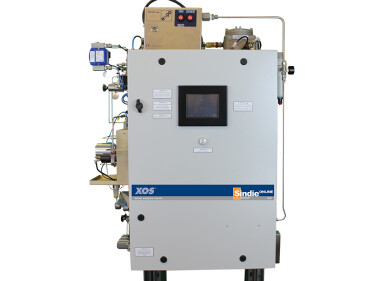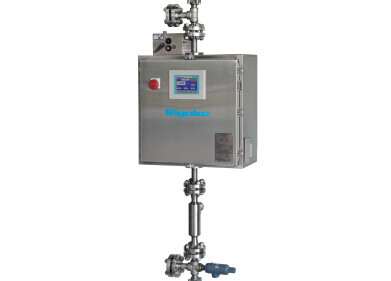-
 Table 2: Repeatability
Table 2: Repeatability -
 Rigaku ZSX Primus Sequential wavelength dispersive X-Ray fluorescence spectrometer
Rigaku ZSX Primus Sequential wavelength dispersive X-Ray fluorescence spectrometer
Sulphur analysis
Sulphur Analysis in Crude Oil & High-Sulfur Fuels by WDXRF According to ASTM D2622-16
Sep 15 2020
Residual fuel oil and high-sulphur diesel fuel are mainly used for boilers and burners, agricultural machines, and long-distance mass transportation means. Sulphur concentration of crude oil and high-sulfur fuels is monitored or controlled in refinery and production processes in the petroleum industry, since sulphur compounds in petroleum contribute to air pollution, metal corrosion and catalyst degradation.
X-ray fluorescence (XRF) spectrometry has been used for quantitative analysis of sulfur in crude oil and high-sulphur fuels including bunker fuel, due to its simple sample preparation requirements. In XRF analysis of oils, samples are simply poured into liquid cells and any complicated treatment such as chemical decomposition or dilution is not required.
This method demonstrates quantitative analysis of high concentration sulfur in crude oil, high-sulfur diesel fuel and residual fuel oil according to ASTM D2622-16 - Standard Test Method for Sulphur in Petroleum Products by Wavelength Dispersive X-ray Fluorescence Spectrometry - on the Rigaku ZSX Primus WDXRF spectrometer.
Instrument
The ZSX Primus tube-below sequential WDXRF spectrometer is optimized for routine analysis that today’s petroleum laboratories need to perform. The programmable, switchable vacuum seal between the sample and optical chambers can keep the optical chamber under vacuum with the sample chamber under helium, and, therefore, minimises helium gas consumption and time of atmosphere change in the sample chamber. The spectrometer is equipped with a 3 kW X-ray tube and the analysing crystals covering F to U in the standard configuration. If higher sensitivity or precision is required, a 4 kW X-ray tube can be mounted.
Measurements shown were performed on the ZSX Primus spectrometer with a 3 kW X-ray tube operating at 30 kV and 80 mA using a Ge analyzing crystal and the S4 slit, included in the standard configuration. The counting time was 20 seconds for peak and 10 seconds for background.
Calibration
Crude oil standards, “Number 2 diesel fuel” standards and residual oil standards were used for calibration. The calibration results are tabulated in Table 1.
Analysis results
Repeatability tests were carried out using a representative sample for each material. For each sample, two aliquots were prepared and quantified with the calibration; this process was repeated twenty times. The test results are tabulated in Table 2 (a) for crude oil, (b) for high-sulfur diesel fuel and (c) for residual fuel oil, in which the average and the difference of two aliquots each are shown. “r” represents “repeatability” defined by
Repeatability (r) = 0.1462·X0.8015 mg/kg (1)
X: total sulphur concentration (mg/kg)
in ASTM D2622-16, which states that the difference between successive test results obtained by the same operator with the same apparatus under constant operation conditions on identical test material would, in the normal and correct operation of the test method, exceed the values calculated by Equation (1) only in one case in twenty.
High power: r = 0.08681·X0.8383 mg/kg
X: total sulphur concentration (mg/kg)
The test results shown in Table 2, where the difference of two aliquots does not exceed the repeatability (r) for each analyte, prove that the performance of the ZSX Primus Spectrometer meets the requirement of ASTM D2622-16 for crude oil, high-sulphur diesel fuel and residual fuel oil.
Standard and sample preparation
Crude oil standards, “Number 2 diesel fuel” standards and residual oil standards provided by VHG Labs were used for calibration of crude oil, high-sulphur diesel fuel and residual fuel oil respectively. The calibration curves are shown in Figure 1 and the calibration results are tabulated in Table 1.
Four milliliter of each sample was poured into a liquid cell (Chemplex® 1095) with analysis film of 3.6 μm Mylar® (Chemplex® 150).
Analysis results
Repeatability tests were carried out using a representative sample for each material. For each sample, two aliquots were prepared and quantified with the calibration (Figure 1); this process was repeated twenty times. The test results are tabulated in Table 2 (a) for crude oil, Table 2 (b) for high-sulfur diesel fuel and Table 2 (c) for residual fuel oil, in which the average and the difference of two aliquots each are shown. “r” represents “repeatability” defined by
Repeatability (r) = 0.1462·X0.8015 mg/kg (1)
X: total sulphur concentration (mg/kg)
in ASTM D2622-16, which states that the difference between successive test results obtained by the same operator with the same apparatus under constant operation conditions on identical test material would, in the long run, in the normal and correct operation of the test method, exceed the values calculated by Equation (1) only in one case in twenty.
For high power instruments having >1000 watt X-ray sources, a non-mandatory repeatability is provided in Appendix of ASTM D2622-16.
High power: r = 0.08681·X0.8383 mg/kg
X: total sulphur concentration (mg/kg)
This value for each material is also shown in Table 2 for reference.
The test results shown in Table 2, where the difference of two aliquots does not exceed the repeatability (r) for each analyte, prove that the performance of the ZSX Primus meets the requirement of ASTM D2622-16 for crude oil, high-sulphur diesel fuel and residual fuel oil.
Conclusion
High concentration sulfur in crude oil and petroleum- based fuels, including bunker fuel, can be routinely analysed with high accuracy and precision on the ZSX Primus, a sequential WDXRF spectrometer, with a 3 kW X-ray tube. This application note demonstrates that the performance of the ZSX Primus meets the requirement of ASTM D2622-16, which has become stricter in the recent versions of ASTM D2622.
Reference
ASTM D2622-16, Standard Test Method for Sulphur in Petroleum Products by Wavelength Dispersive X-ray Fluorescence Spectrometry, ASTM International, (2016), 12pp.
Digital Edition
PIN 26.1 Feb/Mar 2025
March 2025
Analytical Instrumentation - Elemental Analysis for Quality and Process Control at Refineries, for Lubricants and Wear Metals in Engine Oils - Synthetic Lubricants: New Developments - Scaling...
View all digital editions
Events
Apr 08 2025 Birmingham, UK
Apr 08 2025 Kielce, Poland
Apr 08 2025 Ravenna, Italy
Apr 08 2025 Southampton, UK
Apr 08 2025 London, UK






















